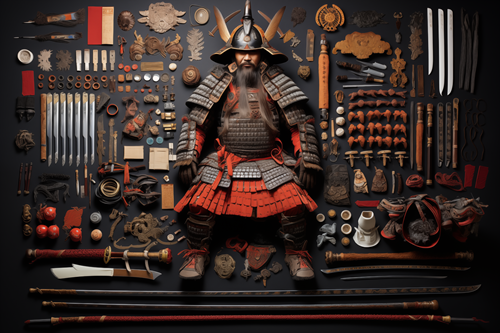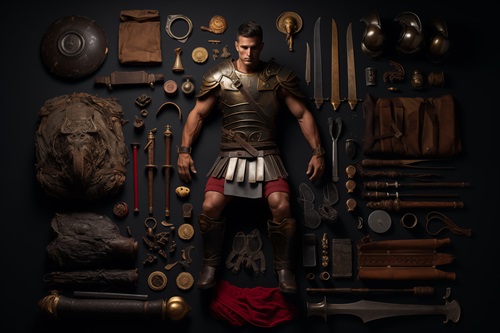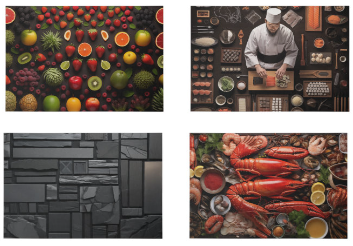
- Details
- Written by: Super User
- Category: Warrior Knolling
- Hits: 386
The samurai, Japan's revered warrior class, have long captured the world's imagination with their martial prowess, unwavering code of honor, andistinctive attire. In this exploration of knolling, an artful arrangement of objects, we invite you to envision a Japanese samurai warrior standing amidst his attire. As we meticulously lay out the elements of this tableau, we'll also delve into the profound role that the samurai played in Japanese history and culture.
I. The Knolling Arrangement
Imagine a captivating tableau where a Japanese samurai stands in stoic reverence, surrounded by the essential components of his identity and duty.
-
The Samurai: At the center of the composition stands our samurai, his posture poised and dignified. He radiates an aura of discipline and unwavering loyalty to the code of Bushido.
-
The Katana: To his side, the samurai's katana rests in its scabbard, symbolizing his commitment to the way of the warrior. This sword, renowned for its craftsmanship and sharpness, embodies the samurai's dedication to the art of the blade.
-
The Wakizashi: A smaller sword, the wakizashi, accompanies the katana, representing the samurai's readiness for close combat and his duty to protect his lord.
-
The Kabuto: Behind the samurai, his ornate helmet, or kabuto, is displayed prominently. It is adorned with family crests and a menacing faceplate, reflecting his lineage and instilling fear in his enemies.
-
The Yoroi: Resting on a stand nearby is a suit of traditional samurai armor, or yoroi. Its lacquered plates and silk cords are meticulously arranged, symbolizing protection, strength, and prestige.
-
The Tengu-Getta: Below the armor, the samurai's wooden clogs, or tengu-geta, rest neatly. These elevated footwear allowed the samurai to navigate muddy terrain while maintaining an imposing height.
-
The Tatami: The tableau is set against a backdrop of tatami mats, signifying the traditional Japanese living space and martial arts practice area. It reminds us of the samurai's constant training and discipline.
II. The Samurai's Role
Beyond the artful arrangement, understanding the samurai's profound role in Japanese history and culture is essential.
-
Protectors and Warriors: Samurai, meaning "those who serve," were the elite warriors of feudal Japan. They served their lords (daimyo) with unwavering loyalty and were tasked with protecting their domains.
-
The Bushido Code: Central to the samurai ethos was the Bushido code, a set of principles that governed their actions. Honor, loyalty, courage, and self-discipline were its core tenets.
-
Cultural Patrons: Samurai played a pivotal role in promoting Japanese culture. They were patrons of the arts, fostering traditional practices such as tea ceremonies, calligraphy, and ikebana (flower arranging).
-
Symbol of Authority: The samurai represented authority and order in a society marked by tumultuous power struggles. They upheld justice and maintained stability during periods of civil unrest.
-
Endurance and Adaptability: Samurai faced not only external threats but also internal challenges as their role evolved. Many adapted to new roles as administrators and bureaucrats during times of peace.
-
Modern Influence: The legacy of the samurai endures in modern Japan, where their ideals continue to shape the nation's values and identity.
In conclusion, the knolling tableau of a Japanese samurai warrior amidst his attire is not just a visual arrangement of objects; it represents the heart and soul of a culture deeply rooted in tradition, honor, and duty. Beyond the meticulous placement of elements, it serves as a symbol of the samurai's enduring legacy—a testament to their pivotal role in Japanese history and their lasting influence on the world's perception of Japan and its warrior spirit.
Buy Traditional Japanese Katchu Samuria Warrior Merchandise

- Details
- Written by: Super User
- Category: Warrior Knolling
- Hits: 341
In the grand amphitheaters of ancient Rome, gladiators were the embodiment of valor and combat prowess. These fierce warriors captured the imaginations of countless spectators, with their battles transcending mere sport and evolving into a symbol of the Roman Empire's power and culture. Today, we delve into the art of knolling, a meticulous arrangement of objects, to portray a Roman gladiator standing amidst his attire. In this intricate tableau, we shall explore not just the visual elements but also the profound significance of the gladiator's role in Roman society.
I. The Knolling Arrangement
Before us stands a representation of a Roman gladiator, meticulously arranged in a knolling tableau. At the center of this display is our gladiator, a muscular and statuesque figure, embodying strength and courage. He is adorned in his distinctive armor, meticulously laid out around him in a deliberate manner.
-
The Gladiator: Our gladiator stands upright, with his feet slightly apart, conveying an aura of readiness for combat. His body is adorned with a finely detailed breastplate, fashioned from gleaming metal and decorated with intricate patterns, signifying both protection and status.
-
The Helmet: Beside the gladiator lies his iconic helmet, known as the "galea." It is a testament to his identity and anonymity in battle, covering his face with a menacing visor, which he would lower when stepping into the arena.
-
The Gladius: A short sword, known as the "gladius," rests at his side. This weapon was his loyal companion, a symbol of his skill and the instrument of his fate.
-
The Scutum: Behind the gladiator, his rectangular shield, the "scutum," leans against the wall. It bears the scars of numerous battles, each dent telling a tale of survival and skill.
-
The Sandals: The gladiator's footwear, leather sandals or "caligae," lies neatly positioned near his feet. These humble yet essential pieces were his only contact with the arena's unforgiving sands.
-
The Arena: The knolling tableau is set against a backdrop reminiscent of the arena's walls, which bore witness to countless spectacles of combat and drama.
II.The Gladiator's Role
Now that we have established the meticulous arrangement, we delve into the deeper significance of the gladiator's role in ancient Roman society.
-
Entertainment and Spectacle: Gladiatorial combat was more than just a sport; it was a spectacle that captivated the hearts of Roman citizens. These battles provided a source of entertainment, offering an escape from the rigors of daily life.
-
Symbol of Roman Virtue: Gladiators were seen as embodying the core Roman virtues of courage, discipline, and endurance. Their willingness to face death in the arena was celebrated as the ultimate test of these virtues.
-
Social Status and Freedom: While many gladiators were slaves or prisoners of war, some volunteered for this life in the hopes of achieving fame and fortune. In rare cases, a gladiator could earn his freedom through his valorous deeds in the arena.
-
Political Tool: Emperors and politicians often used gladiatorial games as a means of gaining favor with the public. Hosting lavish spectacles with skilled gladiators could bolster their popularity and authority.
-
Cultural Influence: The image of the gladiator has left an indelible mark on art, literature, and even modern popular culture. Their stories of struggle and survival continue to inspire and captivate audiences worldwide.
In conclusion, the knolling arrangement of a Roman gladiator standing amidst his attire serves as a poignant reminder of the rich history and cultural significance of these ancient warriors. Beyond the meticulous arrangement of objects, it symbolizes the enduring legacy of gladiators in Roman society—a testament to their bravery, endurance, and the complex interplay of entertainment, politics, and cultural influence in the ancient world.


